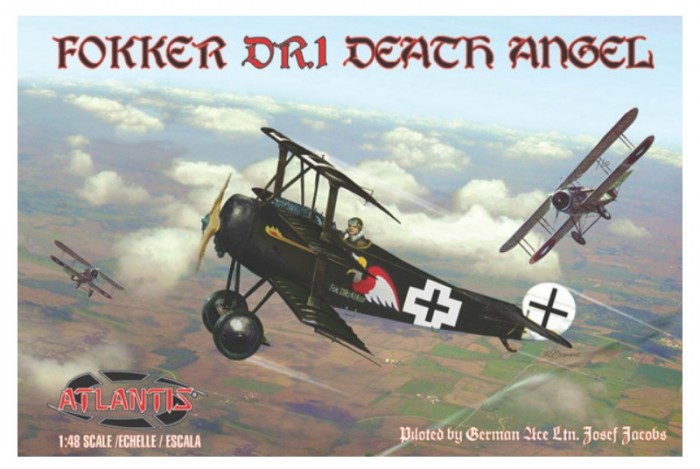|
Back on October 20, 2020 (see page two of this thread) I posted the reply I received from Atlantis about whether they had any of the molds for the extensive Aurora 1:48 collection of WWI aircraft kits.
Disappointingly, they said the only mold they had was for the Fokker Dr. I triplane. It was a long time fixture in Auroras catalog, its popularity enhanced by being the mount of the Red Baron, who became famous fifty years after his 1918 death by being the adversary of Snoopy in the Peanuts comic strip.
Well, they have just announced the release of that kit in the colors of WWI ace Lieutenant Josef Jacobs, the forth highest German ace with 48 victories. His ship was black with winged demon on the fuselage. He was the most successful ace in the Dr. 1.
The kit was first issued in 1956 and remained in their catalog until 1976. The final issue box proclaimed easier wing assembly, but I have not been able to compare the changes. The Scalemates site only shows the early instruction sheet.
I was somewhat surprised by the markings. considering the "go to" scheme for Dr. 1s is usually the all red scheme most famously used by Baron Manfred von Richthofen. It's hard to think of another type so closely associated with one paint scheme, the closest might be various variants of the Curtiss P-40 wearing "sharks mouth" markings. All previous Aurora releases were of red aircraft.
I don't have any information of any alternate decals in the kit, but fans of the Red Baron could still paint their model red and use the black crosses that come in the kit.
While not as famous as Richthofen, Jacobs was no slouch, being awarded the coveted Pour le Mérite, the "Blue Max", in addition to the Iron Cross.
He survived the war, briefly fought communists in the Baltic, and opened an aircraft repair and manufacturing business. He was made a major in the reformed Luftwaffe reserves, but refused to join the Nazi party. When Göring wanted to take over his business, he moved it to the Netherlands. He was active in auto and bobsled racing, passing way at 84 in 1978.
Kudos to Atlantis for coming up with an attractive alternate scheme.
While the Dr. 1 was highly maneuverable, its production life was short and its reputation tainted by a series of wing failures traced to improper construction. Also, it was considered slow compared to other fighters. It was produced for less than a year and only 320 examples were built. By the summer of 1918, it was being replaced by the superior Fokker D. VII. In addition to Richthofen, several other noteworthy German aces flew the Triplane, including Udet, Voss, and Lothar von Richthofen, Manfred's younger brother.
Aurora was a leader in producing kits of WWI aircraft with an impressive range of German and allied types, including some pretty obscure designs. . In addition to the Dr. 1, its German line up included the Fokker D.VII, D. VIII and Eindekker monoplanes, Albatros, Pfalz, Halberstadt fighters and the Gotha bomber.
Allied types were the SPAD XIII, Sopwith Camel and Triplane, SE. 5, Nieuport 11 and 28, Bristol F2B "Brisfit", Breguet 14, DH. 4 observation/bomber as well as the twin engined DH. 10 bomber. And a sole American design...the Curtiss Jenny trainer.
While seemingly on a open cockpit roll, Aurora also offered postwar Being F4B and P-12s, the P-26 monoplane, the Curtiss P-6 ,Douglas M2 mailplane, and the De Havilland Tiger Moth WWII trainer.
The kits were well detailed, often coming with a molded piece of ground and accompanied by a figure of a pilot or a mechanic or two. I received a D. VIII kit as a present as a kit, it was very finely detailed, with crisp details and thin wings.
All were released a few times, some with new box art were among the final Aurora offerings in 1976.
Also, many of the molds were reworked by K&B, and sold in the '80s. Some of the kits are rare, others are found fairly easily an offered at reasonable prices online or at shows. Given the he number of un-built survivors, it makes one think.Aurora must have made a bunch of them.
I give Aurora a lot of credit for this range, they illustrate there was more to the firm than their simple blue Spitfires, yellow Zeros, and red Bf-109s.
Happily, the molds for the Aurora Jenny has also survived and have been recently released by Glencoe (See the August 2022 post. Hopefully you can find the kit, I havent.).
One anecdotal historical footnote...many years ago I read that Charles Shultz, the creator of the Peanuts, got the idea of the Snoopy vs. the Red Baron series when his son built a model of a Sopwith Camel. Now, I have no idea what kit the boy was building; it could of been the large scale Revell kit (1:28, released in 1957), or perhaps a somewhat rare in the U.S., Airfix 1:72 import. It might have been a wood and tissue flying model.
But I'd like to think it was one of the inexpensive and readily available Aurora kits that prompted that bit of pop culture.
101450
| Attachments: |

IMG_20250712_130106.jpg [ 94.32 KiB | Viewed 25709 times ]
|
_________________
Remember the vets, the wonderful planes they flew and their sacrifices for a future many of them did not live to see.
Last edited by JohnB on Sat Nov 01, 2025 4:54 pm, edited 1 time in total.
|





